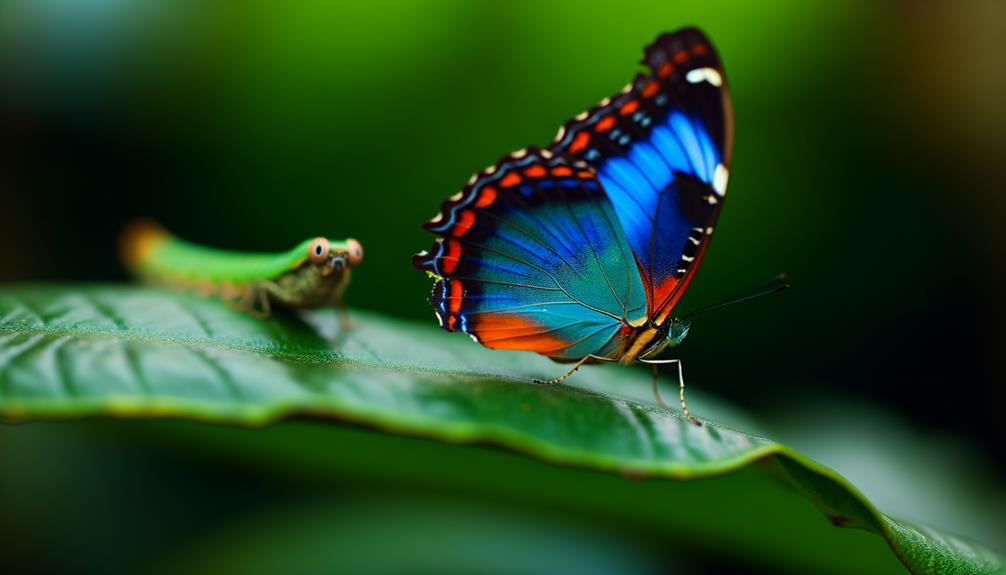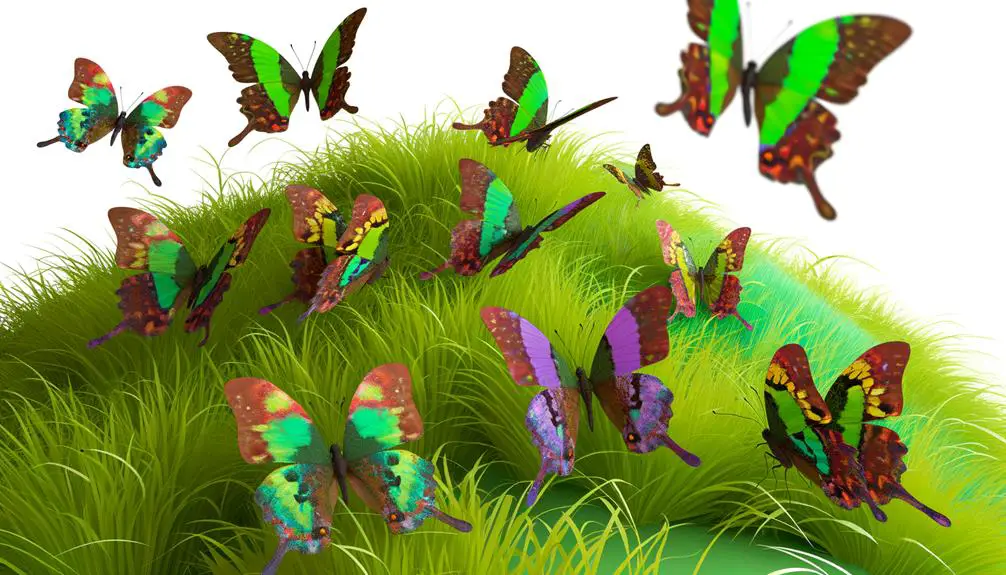Do Butterflies Have Bright Colors for a Reason?
Butterflies display bright colors as part of sophisticated evolutionary strategies for survival and reproduction. These vivid hues can deter predators through aposematism, indicating toxicity, or mimicry, where non-toxic species imitate toxic counterparts.
Bright colors play a substantial role in mate attraction, with males using them to signal fitness and health. In addition, coloration assists in camouflage, allowing butterflies to blend into their environment and evade threats.
Colors also facilitate thermoregulation, with darker shades absorbing heat and lighter ones reflecting it. Moreover, wing patterns serve as significant communication signals for mating and territorial displays.
Exploring these mechanisms reveals the complexity of butterfly adaptations.

Key Takeaways
- Bright colors signal toxicity to predators, deterring attacks.
- Vivid coloration aids in attracting mates and indicating fitness.
- Mimicry of toxic species through bright colors provides protection for non-toxic butterflies.
- Wing colors assist in temperature regulation, ensuring optimal physiological functions.
Predator Deterrence

Butterflies employ a variety of coloration mechanisms to deter predators, including aposematism, mimicry, and cryptic coloration.
Aposematism involves bright, contrasting colors that signal toxicity or unpalatability to potential predators, effectively reducing the likelihood of being eaten.
Mimicry, on the other hand, allows non-toxic butterflies to imitate the warning coloration of toxic species, thereby gaining protection through deceptive appearance.
Cryptic coloration, also known as camouflage, enables butterflies to blend seamlessly into their environment, making them less visible to predators. This adaptation helps butterflies survive by avoiding detection from birds and other predators. The relationship between purple butterflies and mystery is often highlighted in nature, as their unique hues can either serve as a warning or aid in concealment. By mimicking leaves, bark, or flowers, these butterflies increase their chances of evading threats in the wild.
These strategies are essential for survival, as they decrease predation risks and enhance reproductive success.
Each mechanism demonstrates a sophisticated evolutionary adaptation, highlighting the intricate balance between butterflies and their ecological niches.
Mate Attraction
In addition to their role in predator deterrence, vibrant coloration in butterflies also plays a significant role in mate attraction, facilitating reproductive communication and selection. Male butterflies often exhibit more vivid colors to signal their fitness to potential mates. These colors may indicate genetic quality, health status, or successful territory acquisition. Female butterflies utilize these visual cues to discern suitable partners, thereby optimizing reproductive success.
Key aspects of coloration in mate attraction include:
- Species Recognition: Distinct patterns help butterflies identify compatible mates within the same species.
- Sexual Selection: Bright colors are often preferred by females, influencing mating choices.
- Territorial Signaling: Vivid colors can denote a male's dominance and territorial control.
Camouflage and Mimicry

Utilizing the principles of natural selection, butterflies have evolved intricate camouflage and mimicry techniques to enhance their survival by evading predators.
Camouflage allows butterflies to blend seamlessly into their surroundings, making them less visible to predators. For instance, the peppered moth (Biston betularia) exhibits coloration that matches the bark of trees, providing an effective disguise.
Mimicry, on the other hand, involves one species evolving to resemble another more dangerous or unpalatable species. The Viceroy butterfly (Limenitis archippus) mimics the Monarch butterfly (Danaus plexippus), which is toxic to predators. This deceptive resemblance deters potential threats, leveraging the predator's learned avoidance.
Both strategies are essential evolutionary adaptations that contribute greatly to butterfly survival in their natural habitats.
Temperature Regulation
While camouflage and mimicry are essential for evading predators, the ability to regulate body temperature is equally important for butterflies to maintain ideal physiological function and activity.
The vibrant colors on a butterfly's wings play a significant role in thermoregulation. Darker pigments absorb more sunlight, enabling butterflies to warm up quickly, which is crucial for their metabolic processes. Conversely, lighter colors reflect sunlight, helping to prevent overheating in warmer climates.
The structural variations in wing coloration also facilitate effective heat management. Key benefits of bright colors for temperature regulation include:
- Enhanced solar absorption for energy.
- Reflective properties to avoid overheating.
- Structural coloration aiding in heat distribution.
Thus, the colorful wings of butterflies are essential for maintaining thermal balance.
Communication Signals

The intricate patterns and colors on butterfly wings serve as vital communication signals for attracting mates, deterring predators, and establishing territorial boundaries.
These visual cues are often species-specific, ensuring accurate mate recognition and facilitating reproductive success. Bright colors can signal unpalatability or toxicity, a phenomenon known as aposematism, thereby deterring potential predators.
In addition, wing coloration can indicate an individual's fitness and health, playing an important role in mate selection. Ultraviolet (UV) patterns, invisible to the human eye but perceptible to butterflies, add an additional layer of communication, enhancing mate attraction and species differentiation.
Territorial males often display their vibrant wings to ward off rivals, thereby maintaining control over prime mating sites. This multifaceted signaling system underscores the evolutionary significance of butterfly coloration.
Conclusion
The vivid coloration of butterflies serves multiple functions, each essential for their survival and reproduction.
It deters predators, attracts mates, aids in camouflage and mimicry, assists in temperature regulation, and facilitates communication.
Yet, the most astonishing aspect remains the intricate interplay of these functions, finely tuned by evolution.
The true marvel lies not merely in their beauty but in the profound complexity and adaptability of such a simple creature, leaving one to ponder what other secrets nature conceals.





